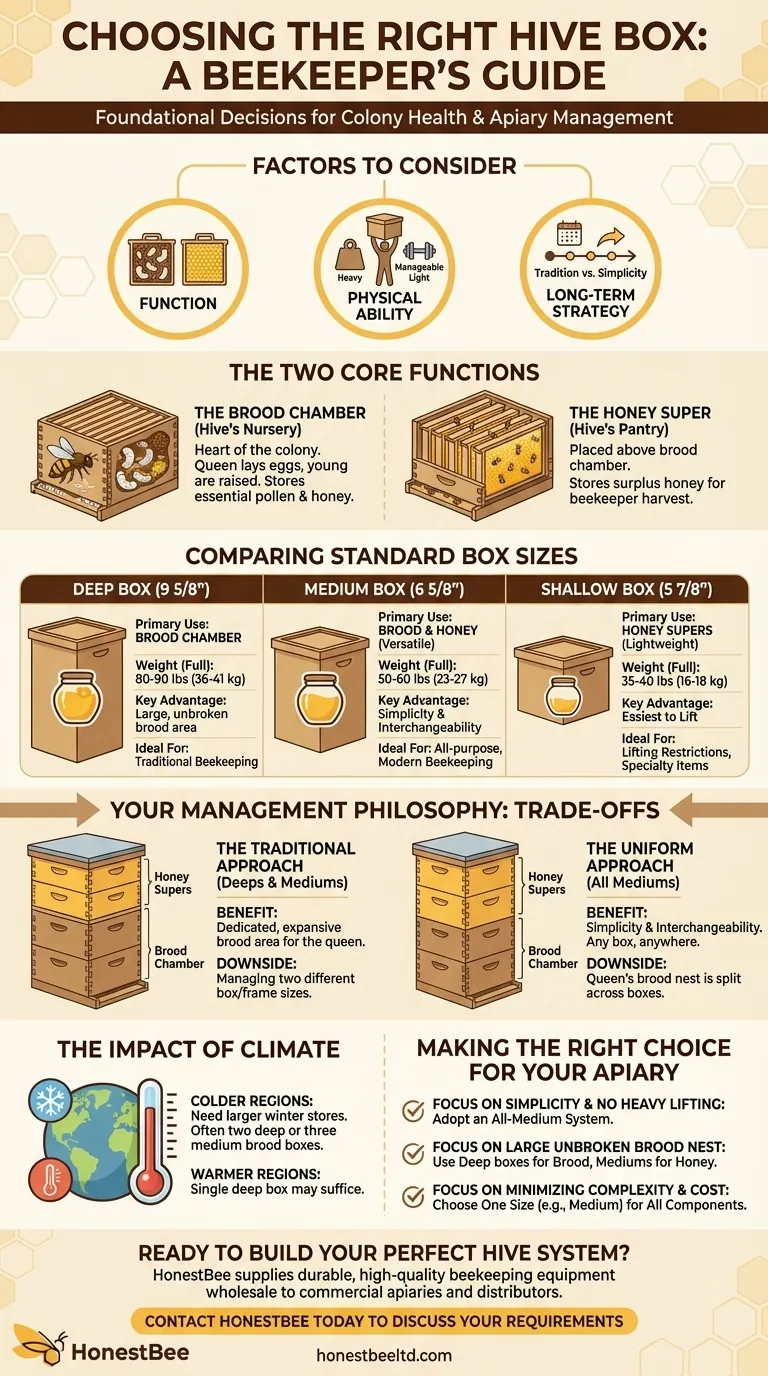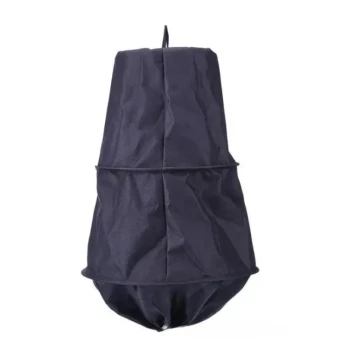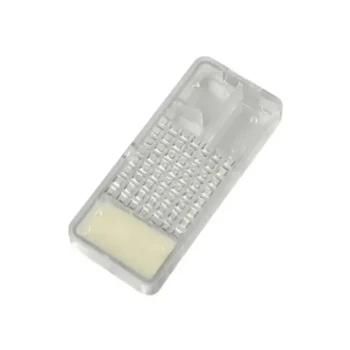Choosing the right hive box is one of the most foundational decisions a beekeeper makes, directly influencing both the colony's health and your own physical effort. The primary factors to consider are the box's intended function (housing the brood or storing honey), the beekeeper's physical ability to lift heavy weight, and the long-term management strategy for the apiary. Different box sizes are optimized for different purposes, creating a system you must manage for years.
The choice of a hive box is not just about the bees; it's about designing a system that works for you. The central trade-off is between providing the queen a large, uninterrupted brood area (the advantage of deep boxes) versus prioritizing lighter, interchangeable components for easier management (the advantage of medium boxes).

The Two Core Functions of a Hive Box
Every standard beehive is a stack of boxes, but not all boxes serve the same purpose. Understanding this functional difference is the first step in making an informed choice.
The Brood Chamber: The Hive's Nursery
The brood chamber, or hive body, forms the bottom of the stack. This is the heart of the colony.
It is where the queen lays her eggs and the colony raises its young (the brood). This area also stores the essential pollen and honey the bees need to survive and feed the next generation.
The Honey Super: The Hive's Pantry
Honey "supers" (from the Latin for "above") are the boxes placed on top of the brood chamber.
Their purpose is to provide space for the bees to store surplus honey. This is the honey that the beekeeper can harvest without jeopardizing the colony's winter survival.
Comparing the Standard Box Sizes
The terms "deep," "medium," and "shallow" refer to the height of the box. While there are several types of hives (Langstroth, Top Bar, Warre), these size conventions are most common in Langstroth hives, the standard in much of the world.
Deep Boxes (9 5/8")
A deep box is the traditional choice for the brood chamber. It provides a large, continuous area for the queen to establish her laying pattern, which many believe promotes a stronger, more populous colony.
The significant drawback is weight. A deep box filled with honey can weigh 80-90 pounds (36-41 kg), making it extremely difficult for many people to lift safely. For this reason, they are rarely used for honey supers.
Medium Boxes (6 5/8")
Medium boxes are the versatile "all-purpose" solution. A medium super filled with honey weighs a more manageable 50-60 pounds (23-27 kg).
They are the most popular choice for honey supers. Many beekeepers also use two stacked medium boxes to serve as their brood chamber, creating a system where every box in the hive is the same size.
Shallow Boxes (5 7/8")
Shallow boxes are the lightest option, weighing around 35-40 pounds (16-18 kg) when full.
Their primary advantage is their low weight, making them ideal for beekeepers with lifting restrictions. They are also favored for producing specialty items like comb honey. However, they are less common and offer less versatility than mediums.
Understanding the Trade-offs: Your Management Philosophy
Your choice of box size is a commitment that defines your beekeeping style. The two most common strategies present a clear trade-off between tradition and simplicity.
The Traditional Approach: Deeps and Mediums
This configuration uses one or two deep boxes for the brood chamber and stacks medium boxes on top for honey supers.
The primary benefit is giving the queen a dedicated, expansive brood area. The downside is that you must now manage and store two different sizes of boxes and frames, adding complexity to your operation.
The Uniform Approach: All Mediums
This modern strategy involves using only medium boxes for everything—typically two or three for the brood chamber and more on top for honey.
The overwhelming benefit is simplicity and interchangeability. Any box can be used anywhere in the hive. This makes management easier and ensures every box is a manageable weight. The main trade-off is that the queen's brood nest is split across two or three boxes.
The Impact of Climate
Your local climate determines how much honey the bees need to survive winter.
In colder regions, colonies need larger winter stores. This often means using a two-deep-box brood chamber or a three-medium-box brood chamber to ensure they have enough food packed away for the long winter. In warmer climates, a single deep box may suffice.
Making the Right Choice for Your Apiary
There is no single "best" box, only the best system for your specific goals and physical capabilities. Consider your priorities to find the right path.
- If your primary focus is simplicity and avoiding heavy lifting: Adopt an all-medium system for both brood and honey.
- If your primary focus is giving the queen a large, unbroken brood nest: Use one or two deep boxes for the brood chamber and medium boxes for honey supers.
- If your primary focus is minimizing equipment costs and complexity: Choose one size (likely medium) and stick with it for all components to streamline purchasing and management.
Ultimately, the best hive system is the one you can manage consistently and safely for years to come.
Summary Table:
| Factor | Deep Box (9 5/8") | Medium Box (6 5/8") | Shallow Box (5 7/8") |
|---|---|---|---|
| Primary Use | Brood Chamber | Brood & Honey (Versatile) | Honey Supers (Lightweight) |
| Weight (Full) | 80-90 lbs (36-41 kg) | 50-60 lbs (23-27 kg) | 35-40 lbs (16-18 kg) |
| Key Advantage | Large, unbroken brood area | Simplicity & interchangeability | Easiest to lift |
| Ideal For | Traditional beekeeping | All-purpose, modern beekeeping | Beekeepers with lifting restrictions |
Ready to build the perfect hive system for your apiary?
At HONESTBEE, we supply durable, high-quality beekeeping supplies and equipment directly to commercial apiaries and beekeeping equipment distributors through our wholesale-focused operations. We can help you source the right boxes—whether deep, medium, or shallow—to create a safe, efficient, and productive hive system tailored to your specific needs and climate.
Contact HONESTBEE today to discuss your equipment requirements and streamline your beekeeping operation for long-term success.
Visual Guide

Related Products
- Australian Langstroth Beehive Boxes for Beekeeping Wholesales
- Langstroth Bee Hives Bee Keeping Box for Beginners Beekeeping
- Langstroth Honey Bee Box Hive Boxes for Different Depths
- HONESTBEE Professional Long Handled Hive Tool with Precision Cutting Blade
- Professional Insulated Plastic Bee Hives
People Also Ask
- What other types of hives are available besides the Flow Hive? Explore Langstroth, Top Bar, and Warre
- What are beehive boxes, and what are they used for? The Essential Guide to Hive Components
- What are the three types of beehives? Find the Perfect Hive for Your Beekeeping Philosophy
- Why might a beginner be advised to start with a Langstroth hive? Unlock a Supportive Beekeeping Ecosystem
- What are the sizes of supers available in a standard hive? A Guide to Deep, Medium, and Shallow Boxes



















